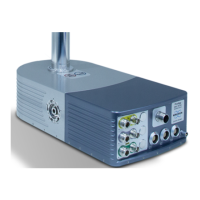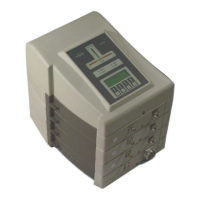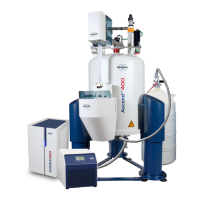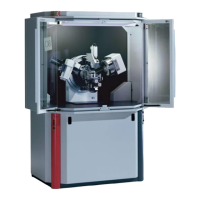RF power limitations
CryoProbe User Manual BRUKER 59 (107)
- of the conventional HPPR modules in the HPPR Technical Manual on
the B
ASH-CD.
For each channel, the lowest value found must not be exceeded by the re-
spective amplifier. Usually, there’s a table in the spectrometer installation docu-
ments that relates amplifier powers in watt to pl settings in dB.
If in doubt, start with powers that are at least 10 dB below the values common
to your conventional probes. Increase them gradually if necessary. Do not exceed
the CryoProbe’s specific maximum power and the HPPR module’s maximum
load.
Simultaneous hard pulses 5.5.2
CAUTION: When two RF pulses are applied to an NMR coil at the same time,
their peak voltages add. Arcing may occur and permanently damage to the coil.
To prevent arcing, the power of two simultaneous hard pulses
1
must be reduced
by 6 dB each. In case of three simultaneous hard pulses, the reduction is 10 dB.
For specific information refer to the ‘L
IMITATIONS - WARNINGS’ sheet.
Average RF power 5.5.3
CAUTION: The decoupling power required by a CryoProbe for a given RF field
strength is much smaller than in a conventional probe.
In cases where the average RF power exceeds the cooling capacity of the sys-
tem, the NMR coil assembly cannot keep its nominal operating temperature. Arti-
facts, unusual noise or a slight mistune/mismatch could occur if the temperature
becomes unstable. In order to warn the operator when the NMR coil assembly
warms up by more than 5 K, C
OLD will start flashing. Should this occur, reduce
the average RF power until the light is steady green again. If most of the average
RF power is due to decoupling during the acquisition, consider a shorter acquisi-
tion time.
However, if the overheating situation is stationary within the first limit, i.e. just
C
OLD flashing but no ERROR, the cooling system usually manages to stabilize the
coil temperature. It might be possible to acquire NMR data of sufficient quality,
perhaps at the expense of signal-to-noise ratio, some mismatching, increased t
1
-
noise etc. Execute a sufficient number of dummy scans.
If this warning is ignored but the NMR coil assembly is heated further, there is a
second factory-set temperature limit of 15 K above the optimum operating tem-
perature at which E
RROR starts flashing. Stop the NMR experiment immediately!
If the NMR coil assembly temperature exceeds the optimum operating tempera-
ture by 20 K, the CryoController warms up the CryoProbe automatically as in-
dicated by a flashing
WARM UP and ERROR.
CAUTION: Should an automatic warm-up be initiated, abort the experiment im-
mediately and make sure that no further RF is going into the CryoProbe.
After the RF-induced heating has been reduced, it is feasible to immediately
COOL
DOWN
again and to restart the experiment (at a lower power level and/or shorter
1 A ‘hard pulse’ is a short pulse at maximum allowed RF power.

